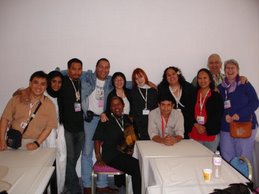A new method of digital rights management (DRM) which relies on a user's profile has been pioneered by Aboriginal Australians.
The Mukurtu Wumpurrarni-kari Archive has been developed by a community based in Australia's Northern Territory.
It asks every person who logs in for their name, age, sex and standing within their community.
This information then restricts what they can search for in the archive, offering a new take on DRM
Dr Kimberly Christen, who helped to develop the archive, told BBC World Service's Digital Planet programme that the need to create these profiles came from community traditions over what can and cannot be seen.
"It grew out of the Warumungu community people themselves, who were really interested in repatriating a lot of images and things that had been taken from the community," she said.
"You find this a lot in indigenous communities, not just in Australia but around the world... this really big push in these communities to get this information back and let people start looking at it and narrating it themselves."
Where to look
Dr Christen, who is an assistant professor based at Washington State University, stumbled across the idea of the archive by chance after meeting a group of missionaries who had digitally archived photos of the Warumungu community since the 1930s.
After loading them onto her laptop, she took them back to Tennant Creek and set up a slideshow - where she noticed that people turned away when certain images came up on screen.

For example, men cannot view women's rituals, and people from one community cannot view material from another without first seeking permission. Meanwhile images of the deceased cannot be viewed by their families.
Offline website
"The way people were looking at the photos was embedded in the social system that already existed in the community," she said.
"People would come in and out of the area of the screen to look when they could look."
This threw up issues surrounding how the material could be archived, as it was not only about preserving the information into a database in a traditional sense, but also how people would access it depending on their gender, their relationship to other people and where they were situated.
Dr Christen and her team of software developers came up with what is described as "a website that's not online", containing photos, digital video clips, audio files, digital reproductions of cultural artefacts and documents.
The system has also been designed with a "two-click mantra" in mind, making the content easy to access for those with low computer literacy skills.
Images are arranged in their own categories, with content tagged with restrictions.
The project believes it has established a cultural solution as well as an opportunity for Aboriginals to collate much of what was once lost. The hope of the project's designers is that as culture and traditions change, history can be rewritten and changed by people themselves.
Source: BBC http://news.bbc.co.uk/2/hi/technology/7214240.stm
The Mukurtu Wumpurrarni-kari Archive has been developed by a community based in Australia's Northern Territory.
It asks every person who logs in for their name, age, sex and standing within their community.
This information then restricts what they can search for in the archive, offering a new take on DRM

Dr Kimberly Christen, who helped to develop the archive, told BBC World Service's Digital Planet programme that the need to create these profiles came from community traditions over what can and cannot be seen.
"It grew out of the Warumungu community people themselves, who were really interested in repatriating a lot of images and things that had been taken from the community," she said.
"You find this a lot in indigenous communities, not just in Australia but around the world... this really big push in these communities to get this information back and let people start looking at it and narrating it themselves."
Where to look
Dr Christen, who is an assistant professor based at Washington State University, stumbled across the idea of the archive by chance after meeting a group of missionaries who had digitally archived photos of the Warumungu community since the 1930s.
After loading them onto her laptop, she took them back to Tennant Creek and set up a slideshow - where she noticed that people turned away when certain images came up on screen.

For example, men cannot view women's rituals, and people from one community cannot view material from another without first seeking permission. Meanwhile images of the deceased cannot be viewed by their families.
Offline website
"The way people were looking at the photos was embedded in the social system that already existed in the community," she said.
"People would come in and out of the area of the screen to look when they could look."
This threw up issues surrounding how the material could be archived, as it was not only about preserving the information into a database in a traditional sense, but also how people would access it depending on their gender, their relationship to other people and where they were situated.
Dr Christen and her team of software developers came up with what is described as "a website that's not online", containing photos, digital video clips, audio files, digital reproductions of cultural artefacts and documents.
The system has also been designed with a "two-click mantra" in mind, making the content easy to access for those with low computer literacy skills.
Images are arranged in their own categories, with content tagged with restrictions.
The project believes it has established a cultural solution as well as an opportunity for Aboriginals to collate much of what was once lost. The hope of the project's designers is that as culture and traditions change, history can be rewritten and changed by people themselves.
Source: BBC http://news.bbc.co.uk/2/hi/technology/7214240.stm



No comments:
Post a Comment